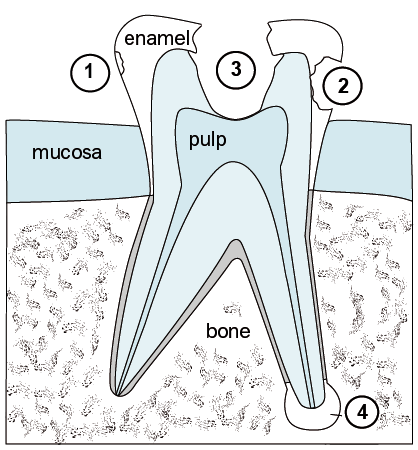Pathology and diagnosis of dental caries
Dental caries (tooth decay) is a pathological process resulting in localised destruction of tooth tissue.
Dental plaque (a complex biofilm of mixed bacteria and their by-products) is a prerequisite for dental caries development. Frequent exposure to dietary sugar and carbohydrates leads to an increase in the population of cariogenic bacteria in the biofilm. Cariogenic bacteria produce organic acids, which lower the pH of the biofilm, resulting in enamel demineralisation (loss of carbonated hydroxyapatite).
Stages of dental caries and Early carious lesions and cavities show the stages of dental caries.

Diagram showing dental caries and its sequelae
1. carious ‘white spot’
2. initial cavity
3. large cavity involving the pulp
4. periapical abscess

Early carious lesions present as white spots on the tooth that have a relatively intact surface. Early diagnosis of carious lesions maximises the opportunities for their arrest and reversal. They can be accurately assessed and monitored by either traditional methods (eg visual and radiographic techniques), or newer technologies involving laser and light-induced fluorescence.
Continued subsurface demineralisation leads to cavitation. If untreated, cavitation gradually progresses through the enamel and dentine towards the dental pulp, leading to:
- pulpitis
- pulp necrosis
- infection of the root canal system
- apical periodontitis
- periapical abscess (see Localised odontogenic infections)
- spreading odontogenic infection.
